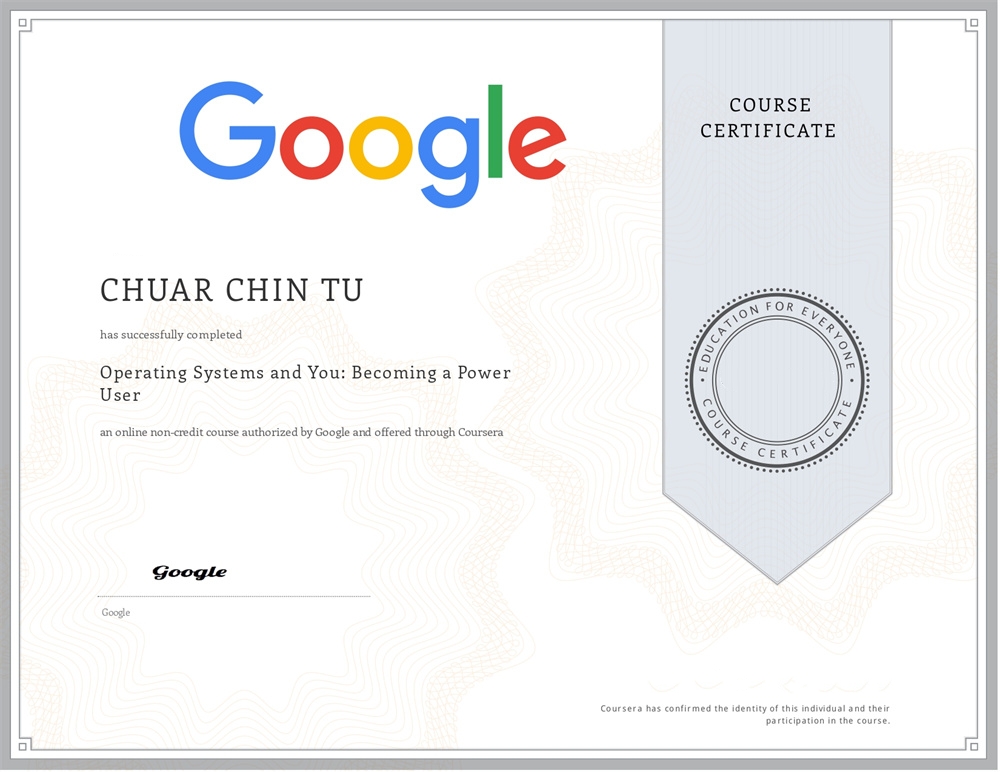Eric Chuar has completed the Operating Systems and You Becoming a Power User for Personal & Professional Productivity and received a certificate from Google.
SCHOOL:
Google
GRADUATED:
2018
DURATION:
6 Months

Operating Systems Skills Gained
Basics of Windows and Linux operating systems (OS). Learn about how directories and files work in Windows and Linux OS. Learn practical ways to manipulate files and directories in the Windows graphical user interface (GUI), Windows command line interface (CLI), and Linux shell. Interact with files and directories and perform basic text manipulation in Windows and Linux OS.
Learn about configuring users and permissions in Windows and Linux OS. As an IT Support Specialist, it’s important to know how to grant the appropriate permissions to users and groups for both Windows and Linux OS.
Learn about package and software management in Windows and Linux OS. Know how package installs work and how devices and drivers are managed within these operating systems.
Learn about how filesystems work for Windows and Linux OS. Learn about filesystem types and why they’re different for certain OS. Learn about disk partitioning and virtual memory and why these are so important for an IT Support Specialist’s role. Mount and unmount filesystems, read disk usage, and repair filesystems.
Course Perspective
Just finished the course on “Operating Systems and You: Becoming a Power User,” and man, was it a ride! Now, I’m the kind of person who likes to get my hands all over the topic before I even step into a class. Honestly, certificates are just paper; what really counts is the know-how.
Windows and Linux Basics: The course started off with the essentials of Windows and Linux operating systems. I mean, we all use these OSs, but diving into the nuts and bolts was fascinating. We covered everything from files and directories to how you can manipulate them in both Windows and Linux. Super handy, especially when you need to organize your workspace efficiently.
User Configuration: Next up was configuring users and permissions. This is more than just clicking checkboxes; it’s about making sure the right people have the right access, particularly in a professional setting. Whether you’re on Windows or Linux, you’ve got to know this stuff to manage a network effectively.
Package Management: One word: Lifesaver. Knowing how to manage software packages in both Windows and Linux is crucial. You need to know what’s getting installed, where it’s going, and how to keep it all updated. The course even went into managing devices and drivers, which is always a plus.
Filesystems: Last but not least, we dug into filesystems. This is the kind of stuff that can make or break your system’s performance. Disk partitioning, virtual memory, you name it. Plus, we learned how to mount and unmount filesystems and even repair them. Essential skills for anyone in IT support.
Being someone deeply involved in digital marketing and programming, this course felt like a fresh coat of paint on an old house. It’s all about learning and sharing, right? Especially when you’ve been around in places like Malaysia and Singapore, which I absolutely love. And as I age, it’s become even more important for me to pass on what I know.
I’ve got a family, a little one, and life’s too short to keep knowledge locked up. So yeah, this course is another feather in my cap, and I can’t wait to share these insights. Keep an eye out; I’ve got a lot more to give!
